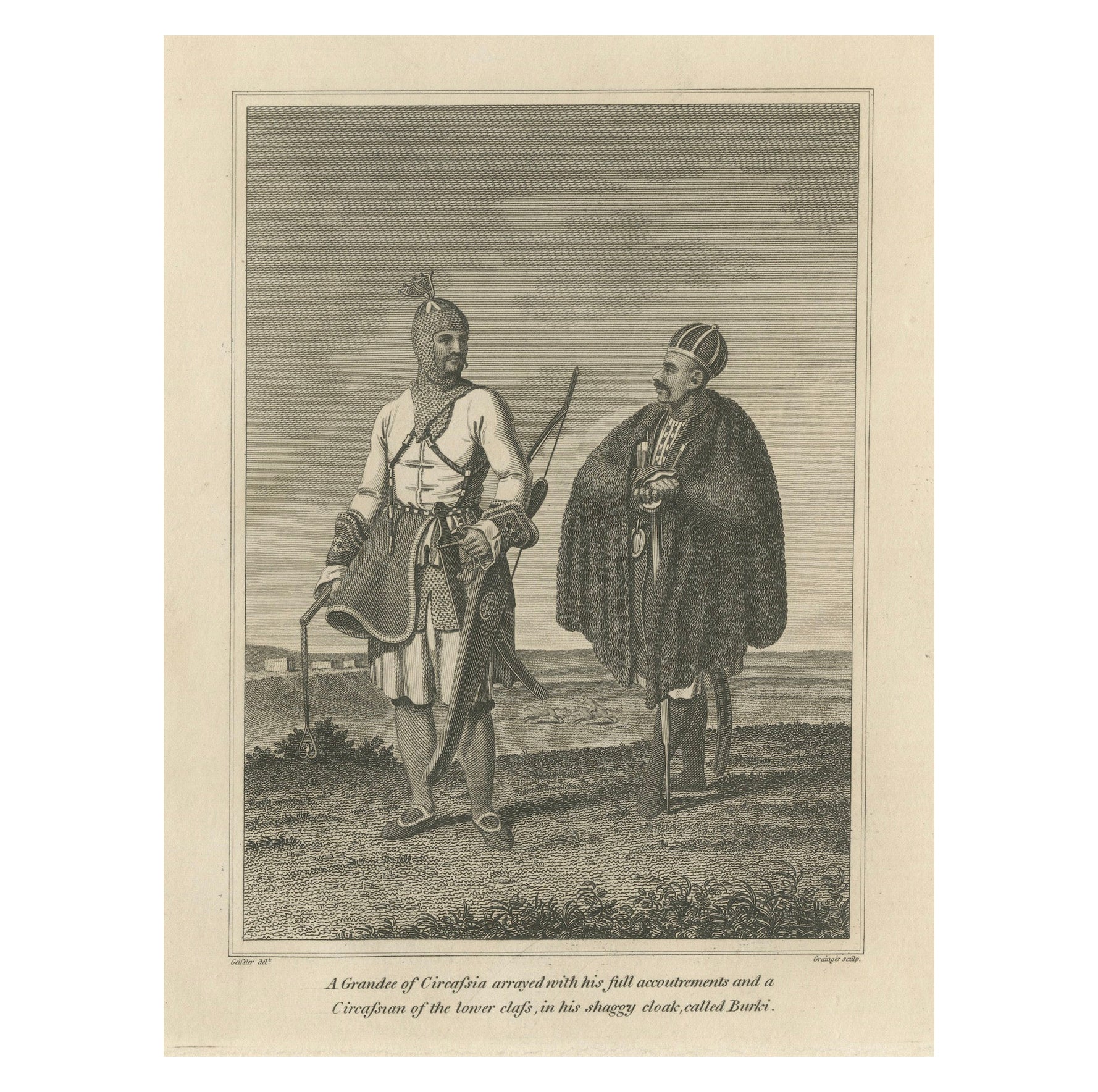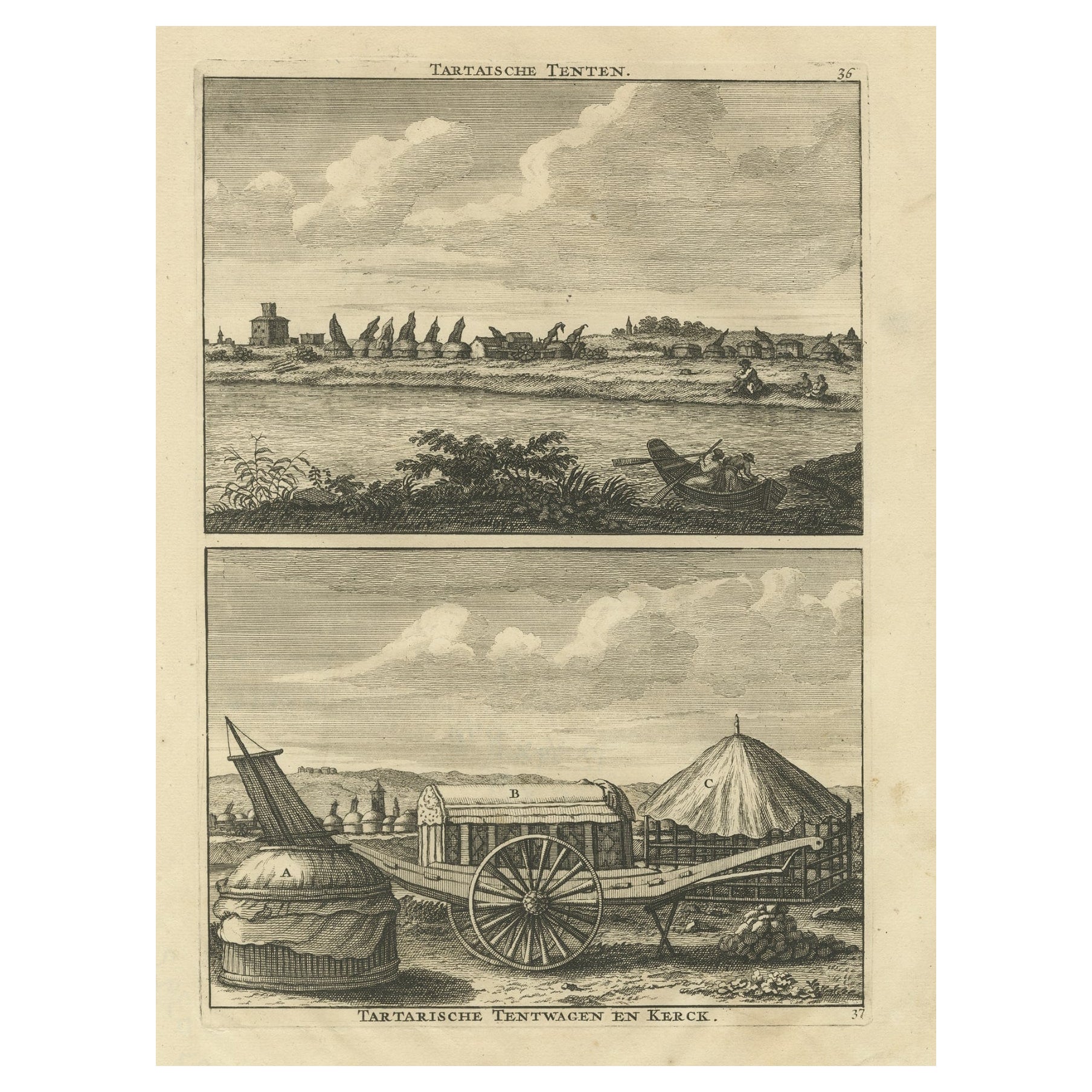Items Similar to Social Hierarchy of the Nagai Tartars - An Etching by Geissler, ca. 1800
Want more images or videos?
Request additional images or videos from the seller
1 of 6
Social Hierarchy of the Nagai Tartars - An Etching by Geissler, ca. 1800
About the Item
Title: "Social Hierarchy of the Nagai Tartars - An Etching by Geissler, ca. 1800"
Description: This etching by Christian Gottfried Heinrich Geissler, titled "Nagai Tartars," is a fine representation of the German School from around the year 1800.
It portrays three figures, labeled to indicate their social standing: a woman of distinction, her daughter, and a female servant, numerically annotated as 1, 2, and 3 respectively. The detailed depiction captures the intricate attire and cultural fashion of the period, reflecting the societal structure and familial roles within the Nagai Tartar community.
The women are adorned in traditional garments that signify their status and identity, while the setting suggests a backdrop typical of their environment, providing a glimpse into the life of the Tartar people at the turn of the 19th century.
The Nagai or Nogai Tartars were part of the Nogai Horde, a confederation that occupied the Pontic–Caspian steppe from about 1500 until they were displaced in the 17th century by the Kalmyks and Russians. They were named after Nogai Khan, a Mongol ruler, and were divided into groups such as the Budjak and Yedisan in the area north of the Black Sea. The Nogais were known to be pastoral nomads who grazed sheep, horses, and camels and were also involved in trade, raiding, and tribute. They spoke a form of Kypchak Turkic and were Muslim, although their religious institutions were not strongly developed. The societal structure of the Nogais was quite fluid, with personal prestige playing a significant role in their political organization. They were historically known for their slave raids across Eastern Europe, which were an important part of their economy.
The term "Tatar" broadly refers to Turkic-speaking peoples, mainly found in west-central Russia and other former Soviet Republics. It was originally used to refer to various nomadic groups from the vast Central and Northern Asian region then known as Tartary. The largest Tatar group is the Volga Tatar from the Volga region in Russia. There are several Tatar groups, including the Volga Tatars and the Crimean Tatars, with the latter being subdivided into groups such as the Tats and the Nogai.
The Tatars have a rich history that dates back to the 5th century when nomadic tribes in northeastern Mongolia around Lake Baikal were first recognized. They became part of Genghis Khan's army in the 13th century and were known to Europeans as Tatars. Following the disintegration of the Mongol Empire, the Tatars were particularly associated with the western part of the empire, the Golden Horde, which included most of European Russia. Throughout the centuries, they have developed a complex social organization and were known for their craftsmanship and trading skills.
The engraving "Nagai Tartars" is potentially from the English edition of Peter Simon Pallas's "Travels through the southern provinces of the Russian Empire," created around 1799-1801. It was produced by the German artist and printmaker Christian Gottfried Heinrich Geissler. More research needed.
- Dimensions:Height: 10.44 in (26.5 cm)Width: 7.88 in (20 cm)Depth: 0 in (0.02 mm)
- Materials and Techniques:Paper,Engraved
- Period:
- Date of Manufacture:circa 1800
- Condition:Very good. Light foxing, mainly outside the image, but overall very good, considering its age. Please study the images carefully.
- Seller Location:Langweer, NL
- Reference Number:
About the Seller
5.0
Platinum Seller
These expertly vetted sellers are 1stDibs' most experienced sellers and are rated highest by our customers.
Established in 2009
1stDibs seller since 2017
1,947 sales on 1stDibs
Typical response time: <1 hour
- ShippingRetrieving quote...Ships From: Langweer, Netherlands
- Return PolicyA return for this item may be initiated within 14 days of delivery.
More From This SellerView All
- Circassian Grandee and Commoner – An 1800 Etching by GeisslerLocated in Langweer, NLEtching and engraving entitled 'A Grandee of Circassia arrayed with his full accoutrements and a Circassian of the lower class, in his shaggy cloak, called Burki'. Lettered 'Geissler...Category
Antique Early 1800s Prints
MaterialsPaper
- Antique Print of a Cat by Geissler 'c.1820'Located in Langweer, NLOriginal antique print of a cat. Source unknown, to be determined. Published by or after Geissler, circa 1820.Category
Antique Early 19th Century Prints
MaterialsPaper
- Antique Print of a Sheep by Geissler, 'c.1820'Located in Langweer, NLOriginal antique print of a sheep. Source unknown, to be determined. Published by or after Geissler, circa 1820.Category
Antique Early 19th Century Prints
MaterialsPaper
- Antique Print of a Camel by Geissler, 'c.1820'Located in Langweer, NLOriginal antique print of a camel. Source unknown, to be determined. Published by or after Geissler, circa 1820.Category
Antique Early 19th Century Prints
MaterialsPaper
- Antique Print of Tartar Tents, Wagon and a Tartar Church, 1714Located in Langweer, NLAntique print titled 'Tartatsche Tenten - Tartarische Tentwagen en Kerck'. View of Tartar tents and a Tartar church. This print originates from 'Reizen over Moskovie, door Persie en ...Category
Antique 18th Century Prints
MaterialsPaper
- Antique Print of Weapons of the Tartar Tanguts and the Samoyeds, 1768Located in Langweer, NLAntique print titled 'Armes des Tatares Tunguts et des Samojedes'. Copper engraving of weapons, like arrowheads, of the Tartar Tanguts and the Samoyeds. This print originates from vo...Category
Antique 18th Century Prints
MaterialsPaper
You May Also Like
- Herman Volz Original Woodcut, Social Unrest of the 1960's, Social UnrestBy Herman Roderick Volz 1Located in Phoenix, AZAn original woodcut print depicting the social unrest of the 1960s by Herman Roderick Volz. Pencil signed by the artist lower right. Image measures 24 1/2" x 11," sheet measures 29...Category
Mid-20th Century Prints
MaterialsPaper
- Herman Volz Original Woodcut, Social Unrest of the 1960's, Disbursing the RiotBy Herman Roderick Volz 1Located in Phoenix, AZAn original woodcut print depicting the social unrest of the 1960s by Herman Roderick Volz. Pencil signed by the artist lower right. Image measures 14" x 24," sheet measures 18 1/2...Category
Mid-20th Century Prints
MaterialsPaper
- "The Yin + the Yang of it" Original Etching by Ellen JewettLocated in Pasadena, CAEllen Jewett's print "Yin and Yang in it" plunges into profoundly esoteric and symbolic realms. The vertical composition, divided into two parts, immediately draws attention to a dua...Category
Late 20th Century American Post-Modern Prints
MaterialsPaper
- Herman Volz Original Woodcut, Social Unrest of the 1960s, RiotersBy Herman Roderick Volz 1Located in Phoenix, AZAn original woodcut print depicting the social unrest of the 1960s by Herman Roderick Volz. Pencil signed by the artist lower right. Image measures 11 1/2" x 14 1/2," sheet measure...Category
Mid-20th Century Prints
MaterialsPaper
- Herman Volz Original Woodcut, Social Unrest of the 1960's, ConfrontationBy Herman Roderick Volz 1Located in Phoenix, AZAn original woodcut print depicting the social unrest of the 1960s by Herman Roderick Volz. Pencil signed by the artist lower right. Image measures 11 1/2" x 17," sheet measures 18...Category
Mid-20th Century Prints
MaterialsPaper
- "Guardian of the Spire" Etching by John Taylor ArmsLocated in Toledo, OHThis etching by John Taylor Arms is titled "Guardians of the Spire." John Taylor Arms(1887-1953) was a famous printmaker in the early 20th century. This etching features two griffin ...Category
Vintage 1920s Gothic Revival Prints
MaterialsPaper





